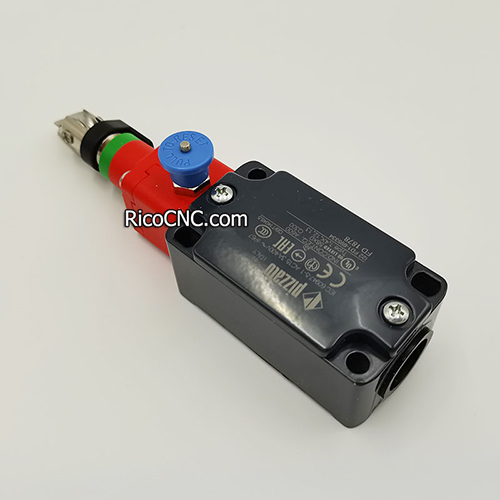What is a limit switch?

The limit switch is first used to define the limit of travel of an object; hence the name "Limit Switch".
A limit switch is an electromechanical device that consists of an actuator mechanically linked to a set of contacts. When an object comes into contact with the actuator, the device operates the contacts to make or break an electrical connection. They are used for controlling machinery as part of a control system, as a safety interlock.
Limit switches include:
Limit switch sensor, plunger limit switch, furnace limit switch, furnace fan limit switch, furnace limit switches, travel limit switch, limit switch omron, limit switch on a furnace, rotary limit switch, magnetic limit switch.
What is a pneumatic solenoid valve?

Pneumatic solenoid valves are electromechanical devices that control the flow of air or process gas. They are mostly used for controlling pneumatic actuators such as cylinders, turbines (pneumatic motors), diaphragms, and tubes. Pneumatic solenoid valves and actuators form auxiliary air circuits.
Pneumatic solenoid valves include:
3-way air solenoid valve 24vdc, pneumatic solenoid valve, parker solenoid valve, electric solenoid valve, hydraulic solenoid valve, air solenoid valve, Festo solenoid valve, three-way solenoid valve, solenoid control valve, air solenoid valve 12v, electric valve solenoid
Limit switch types:

Whisker limit switch, roller limit switch, lever limit switch, and plunger limit switch.
Plunger limit switches have a plunger or push button depressed by the moving object to activate the switch. They are ideal for simple on-off position detection. Their direct contact nature requires precise alignment, and they are not suitable for applications with high cycle rates due to wear on the actuator.
Roller limit switch: Equipped with a roller at the end of a lever, these switches are actuated by the movement of an object that pushes the roller. The roller reduces wear and allows for smoother actuation with less friction. They're versatile, with adjustable levers for different actuation points, but they can be sensitive to misalignment, and the lever can be damaged by excessive force.
Whisker limit switch: Whisker-type limit switches are sensitive tactile sensors that use a thin metal wire or "whisker" to detect the presence or position of objects through physical contact. They are valued for their high sensitivity and simple design, making them suitable for applications in industrial automation, robotics, and safety mechanisms where precise parts detection is necessary.
Pneumatic solenoid valve type:

Pneumatic solenoid valves are based on the number of ports, positions, and ways of a valve. These valve positions and ports define the various functions that a valve can perform. Here is what each term means and applies to pneumatic solenoid valves.
Ports - These are openings (orifices) or connection points available on the valve body. These openings can be inlets or outlets on the pneumatic solenoid valve, permitting compressed air (gaseous media) to flow through.
Position - the position of a valve refers to the state of flow paths or passages. They determine how different compressed air flow paths connect or restrict flow. Specific valve positions permit air to flow through the pneumatic valve ports while others block the flow.
Ways - These are existing flow directions or predefined paths that compressed air can follow when flowing through the pneumatic solenoid valves.
2/2- Way Pneumatic Solenoid Valve, two ports and two positions. The two ports are an inlet or supply port and an outlet/exhaust port. The two ports provide entry and exit points from the pneumatic directional control valve, providing limited control of compressed air
3/2-Way Pneumatic Solenoid Valve, three ports, and two valve positions. The three ports in such a pneumatic valve configuration are: Inlet or supply port, Outlet or exhaust port, Working port
5/2-Way Pneumatic solenoid Valve, five-valve ports, and two positions. The five ports are:
Two exhaust ports, Two working ports, and One inlet/supply port.
5/3-Way Pneumatic Solenoid Valve, five ports and three positions namely, Normally closed, Normally open, Center position

Application of limit switch and pneumatic solenoid valve:
Limit switches are used in a variety of applications and environments because of their ruggedness, ease of installation, and reliability of operation. They can determine the presence or absence, passing, positioning, and end of travel of an object, or industrial machine.
Pneumatic solenoid valve is used in medicine, pharmaceuticals, and food and beverage production, industrial machines.

RicoCNC can supply a series 2/2- of pneumatic Solenoid Valve, 3/2-Way Pneumatic Solenoid Valve, 5/2-Way Pneumatic solenoid Valve, 5/3-Way Pneumatic Solenoid Valve, whisker limit switch, roller limit switch, lever limit switch, and plunger limit switch.
If need such requirements, welcome your inquiry.

Tel:+86-51268235075
Fax :+86-51268235075
Mobile:+86-13390848665
E-mail: cncsale@ricocnc.com
Skype: ccsalce
Whatsapp: +86-13390848665


